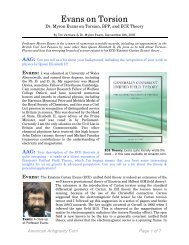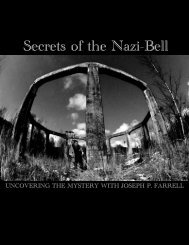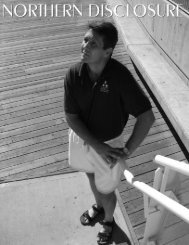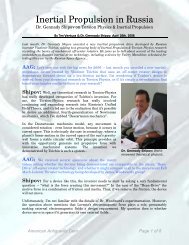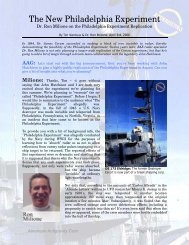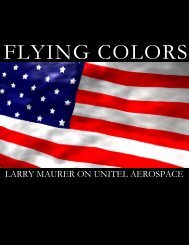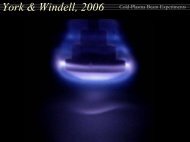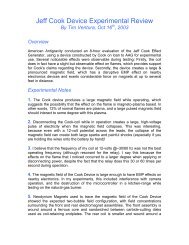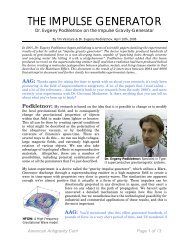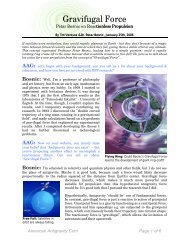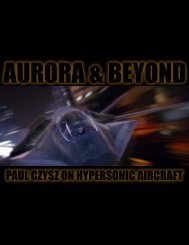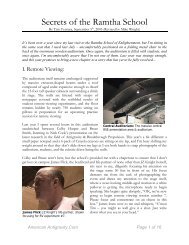A Conversation with Eric Davis - American Antigravity
A Conversation with Eric Davis - American Antigravity
A Conversation with Eric Davis - American Antigravity
- No tags were found...
You also want an ePaper? Increase the reach of your titles
YUMPU automatically turns print PDFs into web optimized ePapers that Google loves.
A <strong>Conversation</strong> <strong>with</strong> <strong>Eric</strong> <strong>Davis</strong>By Tim Ventura & <strong>Eric</strong> <strong>Davis</strong>, PhD, February 4, 2005Dr. <strong>Eric</strong> <strong>Davis</strong> is a physicist specializing in Breakthrough Propulsion & Power Physicsand Astrophysics at the Institute for Advanced Studies at Austin/EarthTech International,Inc. He's agreed to speak about his past experiences in breakthrough physics research,as well as his current leadership role at the STAIF Conference.AAG: First things first: you just started a new job at EarthTech Internationalworking <strong>with</strong> doctors Hal Puthoff & Michael Ibison. Tell us a bit about how thingsare going, and some of the projects that you've taken on <strong>with</strong> their team?<strong>Davis</strong>: It's actually the Institute for Advanced Studies at Austin, andEarthTech International, Inc. is the corporate parent. Work is going really verygood. We are exploring fundamental questions concerning the relationship of thequantum ZPE to gravity, inertia and particle mass, and the development ofschemes to effectively tap the ZPE for power generation, etc. We are alsoadvancing theoretical work on Hal's Polarizable-Vacuum Representation ofGeneral Relativity in order to develop toy models for understanding generalrelativity-related FTL propulsion schemes (such as warp drives and traversablewormholes), and how we might find clues from the model to engineer these in thelab, etc.In that connection, Hal Puthoff, Claudio Maccone (Italian physicist who recentlyretired from Alenia Spazio) and myself published a new paper on this effort,which will appear in the March 2005 issue (vol. 37, no. 3) of the peer-reviewedscholarly physics journal "General Relativity and Gravitation." In the paper weanalyzed Levi-Civita's artificial gravity spacetime metric in terms of Hal's PV-GRmodel and developed the equations showing how either an electric field or amagnetic field will alter the vacuum index of refraction and subsequently modifythe speed of light in the artifically-induced gravitational field region.Also, EarthTech/IASA serves as a clearing house for evaluating and testing thenumerous alternative power generation inventions (such as fuel cells, ZPE, coldfusion, etc.) that are brought to us from all over by maverick inventors. One cango to our website www.earthtech.org and see the papers and experiments postedthere.AAG: From what I understand, the main research area for Earthtech hasn'tbeen space-science -- hasn't it been focused on Zero Point Energy? Can you tell usa bit about how ZPE research is coming along, and if we'll see any realapplications for this in the next few years?<strong>American</strong> <strong>Antigravity</strong>.Com Page 1 of 8
<strong>Davis</strong>: I answered most of this in my response above. I cannot comment onspecific proprietary research, but I can say there are ideas we are looking into forthe theoretical development and experimental implementation of tapping ZPEfor power generation. All of this is in the works, so there is nothing I can reporton.AAG: You've done some remarkable speculative physics research, and I'mwondering how your life experience & training led you into this type of work.<strong>Davis</strong>: Actually, I was led to this type of work by the pioneering research andpopular papers/books/articles published by Dr. Robert L. Forward and hiscolleagues during the 1970s, which ignited an intense spark <strong>with</strong>in me thatfostered my childhood dream of someday being able to fly to the stars on a warpdrivestarship, and being one of the guys to invent the physics.I was also a huge fan of the TV shows Star Trek, Lost In Space and The OuterLimits when I was a kid (and I still am a fan!!). In addition, the Dept. of Defenseand the MacArthur Foundation produced (via film producers Robert Emeneggerand Allan Sandler) a 1974 TV documentary that strongly influencedme: UFOs:Past, Present & Future, which was a Golden Globe nominee for best documentaryproduction in 1975, and it was later updated and re-released in1979 as UFOs: ItHas Begun. I also watched all the ground-breaking classic science fiction moviesof the 20th century, among my favorites are: The Time Machine, The War of theWorlds, The Day The Earth Stood Still, Forbidden Planet, the Star Wars movies,the Star Trek movies, the Alien movies, 2001: A Space Odyssey, Planet of theApes, Close Encounters of the Third Kind, ET: The Extraterrestrial, etc.Starting in middle school I read all the Science News and Scientific <strong>American</strong>magazines; and I read lots of science fiction novels written by Isaac Asimov,James Blish, Arthur C. Clark, H. G. Wells, Ray Bradbury, Frank Herbert, andLarry Niven. I also read scientific and investigative journalism books written byCarl Sagan, Jacques Vallee, Carl Sagan and Thornton Page, Howard Blum, PaulDavies, Robert Emenegger, John Fuller, Donald Keyhoe, Allen Hynek, BradSteiger, etc. Other books I read were a variety of physics and physics historybooks; most pertaining to particle physics and unified field theories, Einstein'srelativity theories, quantum theories, and space exploration.All of this plus the real-world R&D work being done in the 70s-80s on futureflight propulsion physics by Hughes Research Lab (then in Malibu, CA), the AirForce, NASA, Boeing, McDonnell-Douglas, etc. ignited that huge spark <strong>with</strong>inme.Another much later turning point for me (that turned on that inner spark evenhigher) was when I read Robert Forward's 1988 book "Future Magic" while ingrad school. In that book Bob wrote about his conceptual physics explainingtelepathy, dousing, consciousness, and the spirits of deceased people. That wassurprising considering that the topic of the book had to do <strong>with</strong> FTL physics,space and time warps, antimatter rockets, etc. What a blast!<strong>American</strong> <strong>Antigravity</strong>.Com Page 2 of 8
And, if you don't already know this, Bob was Joseph Weber's Ph.D. grad studentin the 1960s at the University of Maryland, where they did pioneering researchdeveloping gravity wave detectors. Bob's first prototype detector is now in theSmithsonian Institute Museum in Washington DC. Bob was a winner of theannual international general relativity physics essay competition, was awarded aHughes Corporation graduate student fellowship to do gravity research <strong>with</strong>Weber, published numerous technical papers and was awared patents, and sawmany of his gravity detection sensors launched on Air Force satellites. Hiswinning essay was about his discovery of antigravity force solutions in Einstein'sgeneral relativity theory. I pointed out this work (in connection <strong>with</strong> myupcoming Advanced Propulsion Study for the Air Force) in a January 2004briefing to the Air Force Research Lab.Anyway, I first met Robert Forward, Robert Bussard, Alan C. Holt, Dave Froningand others at the annual AIAA Joint Propulsion Conference in Las Vegas duringthe summer of 1979. I had just finished high school then. UFOs and theirhypothetical propulsion physics, warp drives, fusion ramjets, antimatter rockets,photon and laser rockets, etc. were all the rage among the large mainstreamaerospace and military defense corporations, U.S. military and NASA physicistsand engineers of the time. The AIAA's annual joint propulsion conferences had"Future Flight" sessions where research into these topics were presented asserious technical papers. That tradition continues today, more or less, in theguise of the Breakthrough Propulsion Physics technical paper sessions and theSTAIF's Near and Far Term Propulsion Concepts sessions.I established a correspondence relationship <strong>with</strong> Bob Forward and Alan Holt thatwent on (off and on) for the first 5 years while I was in college and going on tograd school. But my correspondences and personal face-to-face interactionsbecame more steady and continued for 20 years thereafter. All told, I have knownthese individuals for 26 years. Although, Bob Forward died from an inoperablebrain tumor in Fall 2001, and this was awful for everyone who knew him.Bob Forward began mentoring me in the area of breakthrough propulsion andpower physics (a.k.a. BPP) by first introducing me to all of his Hughes/Air Forceresearch studies on antimatter physics, antimatter rocket propulsion, etc. Hismentoring evolved to include his research into exploiting the quantum vacuumzero-point energies/fluctuations, Einstein general relativity FTL schemes leadingto warp drives and traversable wormholes, exploring and exploiting psychicphenomena, exploring "new physics", exploring the known anomalies (or findingnew ones) in current theoretical and experimental physics to find potentialbreakthrought propulsion and power.Bob sent me copies of all his reports and the reports of other physicists/engineershe worked <strong>with</strong>, and he put me on his Mirror Matter Newsletter membership, etc.He sent me everything he published that was of relevance to breakthroughpropulsion physics (BPP). When I started grad school Bob told me the bad newsthat there were no graduate Ph.D. degree programs in this field, so I would haveto get a Ph.D. in some discipline of physics I liked and get a job in industry if I<strong>American</strong> <strong>Antigravity</strong>.Com Page 3 of 8
wanted to pursue this area professionally as a full-time career. But he said eventhen that industry and government was not fully funding this area of research forthe long-term.In 1989 I met <strong>with</strong> Bob at an AIAA conference and told him I had turned in myPh.D. dissertation and was waiting for my doctoral oral defense to be scheduled,and that I expected to soon be graduated and available for employment. He gaveme more bad news. There were no industry jobs left where I could do BPPresearch because of corporate retrenchment across the U.S. due to the beginningrecession and the fall of the Berlin Wall and communism in Russia created amove to cut down the DoD budget.So my potential career got derailed. I couldn't do postdoc work in myastrophysics discipline because that too was being affected by decisions in thefirst Bush Administration to cut down NASA spending on space exploration, ofwhich I was a part during my graduate work. With space science research fundingbeing cut, there were no forseeable postdoc positions available in areas I wasexperienced to work in.So I had to resort to teaching jobs at community colleges and universities to getby. In the mid-1990s I ended up traveling around Asia while working for the U.S.Air Force under contract through the University of Maryland.After my stint in Asia <strong>with</strong> the AF, I was recruited for a new job in Las Vegasworking as a research physicist at the National Inst. for Discovery Science. It isthere where I was first introduced to Dr. Hal Puthoff who served on the NIDSScience Advisory Board. However, it was because of my association <strong>with</strong> BobForward that I first became aware of Hal's scholarly physics journal publicationson ZPE research while I was in grad school since Bob was following Hal's workand reported on it in one of his later Air Force studies.Before I finished grad school, I got on the bandwagon of the 1985-89 researchdone and papers published by Kip Thorne and his students on traversablewormholes and time machines. In the 1990s when I was in S.Korea working for the Air Force and U.S. Forces Korea, I continued my researchinto that subject and later linked up <strong>with</strong> a black hole astrophysicist at KunsanNational University. Then things in the physics community really began to heatup when Paul J. Nahin's book "Time Machines", Matt Visser's book "LorentzianWormholes" and Kip Thorne's book "Black Holes & Time Warps" were published.These showed that wormholes, space warps and time machines had become amainstream cottage industry of research in physics. I began to hope that thebreathrough propulsion physics field would then take off and get the seriouslong-term funding it deserved.In 1997 the NASA-LeRC (now known as the John Glenn Research Center) andNASA-JPL began the official BPP program following the publication of thesebooks, and Hal was invited by the program manager at NASA-LeRC (Marc Millis)to join the effort. Hal liked my preliminary work on traversable wormholesbecause I showed him that aspects of the quantum vacuum zero-point energy can<strong>American</strong> <strong>Antigravity</strong>.Com Page 4 of 8
provide the special mass-energy field needed to generate a space warp ortraversable wormhole. So he and Marc Millis brought me into the NASA BPPprogram. Bob Forward, Al Holt, Frank Mead (Advanced Concepts Office at AFRL,Edwards AFB, CA), and Dave Froning were also among those involved. So from1997 to the present Hal and I and our colleagues have been working together onbreakthrough propulsion physics in one form or another.It was during my early years at NIDS that Hal took over as my BPP mentorbecause Bob Forward's involvement in the BPP field was winding down as he wasshifting his interests into other directions like writing science fiction novels,getting his space tethers business off the ground, and getting ready for fullretirement.Even though the NASA BPP program ended up losing funding, Hal and Icontinue to work together on our favorite BPP topics, and we also continue tocollaborate <strong>with</strong> Frank Mead, Al Holt, Dave Froning, and others who are in ourcircle.I was laid-off from my job at NIDS in Spring 2002 along <strong>with</strong> the other principalstaff and science advisory board members, so I went into business for myself as acontractor/consultant to the Air Force Research Lab's Advanced Concepts Office(working for Dr. Frank Mead) at Edwards AFB, CA.In the summer of 2001 Frank Mead approached me to do advanced conceptscontract work for him because Bob Forward was no longer available to do BPPresearch studies for AFRL. So in the fall of 2001 I formed my company WarpDrive Metrics (but did not register it as a business in Las Vegas). My first AFRLcontract (the Teleportation Physics Study) began in February 2002, four monthsbefore I learned that Bigelow was going to begin the massive lay-offs at NIDS. Mysecond AFRL contract (Ball Lightning Study) begin in April 2002 and endedJanuary 2003, and that report was published in May 2003. I still have two othercontracts that I completed, and publication of those contract reports is pending.I'm wrapping up a fifth contract now, but it is an editorial re-write of someoneelse's final report.AFRL advanced concepts program funding was severely cut in FY04 because ofmajor reshuffling of Air Force research priorities, so I was forced to find otheremployment. Last fall I was offered, and I accepted, a job offer to work for Hal atEarthTech Int'l/IASA. I moved to Austin, TX last November to start my new job.AAG: A few months ago, the Air Force commissioned you to write a report onteleportation. I've read it cover to cover, and it looks like a blueprint for a real-lifeStarGate technology. Can you tell us anything about your findings?<strong>Davis</strong>: The Teleportation Physics Study contract was officially commissionedin February 2002. It ended in July 2003, and the report was finally published bythe Air Force in Aug. 2004.<strong>American</strong> <strong>Antigravity</strong>.Com Page 5 of 8
It is physically possible, in principle (based on Einstein's general relativity theoryand also on a toy model for FTL flight based on Hal's Polarizable-VacuumRepresentation of General Relativity), to build a traversable wormhole (in theform of a stargate). But we have a long way to go before we can get a handle onthe technology for creating the negative energy density required to hold open andstabilize such a thing. We have good technical ideas on how to do this, but morework needs to be done to shore up those ideas and get a feel for the numbers thatwill be involved on an experimental level, and we need to examine how to bestdemonstrate a wormhole in the lab once we do get a handle on negative energygeneration.The latest published paper by Matt Visser and his colleagues proved that one cansignificantly relax the demand for a large amount of negative energy density, suchthat we can now consider arbitrarily (near-zero) small amounts for the creationof a traversable wormhole. That means the demand on any particular technologyto produce a negative energy density field can be dramatically reduced toworkable laboratory scale. There is now an opening for us to do a labdemonstration once we develop a negative energy generation system that canproduce a quantifiable amount of negative energy in a confined way.Quantum teleportation will continue to evolve. The negative effects ofdecoherence upon the entanglement process is now becoming well understoodand brought under control, so that the fidelity of teleporting the quantum statesof large samples of atomic matter and photons has improved and will continue todo so. The science will evolve to demonstrate the teleportation of molecular statesand later on large samples of molecules will have their states successfullyteleported. Other quantum teleportation breakthroughs will continue to beannounced, and these will involve teleporting other features and facets of matterand information that we have yet to fathom.It will become possible in the future to forsee dabbling in the quantumteleportation of live beings and bulk inanimate matter (like cargo). But this willinvolve the destruction of their physical quantum states in order to teleport thosestates to another "glom" of matter, thus destroying the originals. This will createdifficult ethical questions that will have to be considered.AAG: Next, I wanted to ask about the feedback you received from theteleportation study. I'm sure that the Air Force gets tons of fan-mail asking aboutwhen they're going to build something like we've seen in StarGate SG-1, and I'mwondering if it made them nervous to see a speculative proposal for the sameidea coming across their desk. Did they take it well?<strong>Davis</strong>: The Air Force doesn't know what it does because it's such a largebureaucracy. The teleportation study only came to the attention of commandersat WPAFB, the Pentagon, and members of Congress when the media bruhahabroke out. The Air Force took it all very well in the end, though.<strong>American</strong> <strong>Antigravity</strong>.Com Page 6 of 8
However, the AF was caught off-guard and surprised by the unexpected outburstof media attention and the accompanying outcry that came from the professionalpolitical, national security and scientific agitators in society. But in the end, theAF supported the study because it had to, because it is required to (see below forspecifics on this).What these agitators and self-appointed pundits don't understand about thefederal government is that there are major policy and statutory requirements thatall U.S. military research labs must explore, investigate, and conduct out-of-theboxresearch in areas not usually considered mainstream in order to uncover allpossibilities for expanding the envelope of presently known science and/or todiscover new science in support of future military needs and missions. This iswhy the AFRL's Advanced Concepts Office at Edwards AFB commissioned theteleportation physics study. DARPA's R&D mandate is another example of thesepolicy/statutory regulations.AAG: Speaking of TV, since you've done the study, if Hollywood called you upto consult for the TV show, would you give it any thought?<strong>Davis</strong>: Sure! Many qualified scientists already do this. NASA has personnelwho consult to the film/TV studios on productions related to spaceflight, spacescience fiction, etc.AAG: You have a big event coming up in February -- it's once again time forthe annual STAIF conference, and you're on the panel of scientific experts whoreview submitted papers. Can you give us a bit of background about the STAIFconference, as well as your participation in it?<strong>Davis</strong>: I'm presenting an invited oral paper on the wormhole-stargate aspectof teleportation, which is based on the AFRL study.STAIF is the Space Technologies & Applications International Forum that isannually hosted/sponsored by the Univ. of New Mexico's Institute for Space andNuclear Power Studies in Albuquerque. The symposium is comprised of anumber of different technical conferences that have an emphasis on spacetechnology development. The part I am involved <strong>with</strong> is the space nuclear powerand propulsion conference which is the venue for the Future Frontiers sessions.These are where the BPP related papers will be presented. The sessions includepapers on detecting and harnessing high frequency gravity waves for propulsion,wormholes, warp drives, anomalies known in present theories and experimentsin physics from which we might derive some kind of BPP technology, FTLcommunications, other FTL flight concepts, antimatter rockets, advancedantimatter-augmented nuclear fusion rockets, ZPE-based space drives, differentproposals for propellant less propulsion, antigravity, gravity/inertia modificationtheories and experiments, etc.The talks are all quite diverse and comprehensive.<strong>American</strong> <strong>Antigravity</strong>.Com Page 7 of 8
The papers that get presented as talks at the symposium and published in theproceedings (published by the <strong>American</strong> Inst. of Physics Press) are all peerreviewedfor quality and efficacy. Our Future Frontiers paper review panels striveto include scientifically sound (credible!) AND cutting-edge non-mainstreamconcepts, while making sure to weed out the pathological crackpot elements thattend to infest the BPP and alternative energies/alternative physics fields.AAG: The Gerstenstein Effect is one STAIF proposal that caught my eye --Gary Stephenson has been suggesting it as one possible explanation for thesegravitational force-beam experiments that we've been hearing about. Anycomments on this effect, and whether it's worth building an experiment to test?<strong>Davis</strong>: Exactly! And it is for this reason that I support such experimental workon this topic. It has only been possible to implement this kind of experiment inrecent years because technology caught up <strong>with</strong> the theory, which was originallypublished in the 1960s.AAG: We've talked a bit about Dr. Ning Li in the past -- she sent me an emailin 2003 indicating 11-kilowatts of output effect, and apparently nobody's heardfrom her since then. I haven't been able to make heads or tails of this, but fromwhat I gather she's completely disappeared. Do you think this means she's ontosomething big?<strong>Davis</strong>: No, not really. It might mean she was unable to measure any effectfrom the device she tested for the Army, and so has been forced to find otherfinancial support to stay in business. The terms of her Army contract were clear,she was to produce a report stating in the positive or negative on theexperimental efficacy of her A/C gravity theory. Hal and I saw her at the May2003 MITRE Corp.'s Int'l HFGW Conference, and she reported in her talk thatthe A/C gravity field at a Cu nucleus arising from the magnetic dipole effect is ~10^-2 milli-gees (which translates to ~ 10^-4 m/s^2 acceleration effect).AAG: What are some of the benefits associated <strong>with</strong> presenting an idea atSTAIF, and how can people learn more about it?<strong>Davis</strong>: The purpose of STAIF is to communicate the results of recentengineering and scientific research to all other aerospace, nuclear power andpropulsion workers, to communicate the results of work that is of relevance tothese fields. One can go to the STAIF website and find out more about them.AAG: Time for the Final Question: What are your plans for future research?<strong>Davis</strong>: Wormholes, warp drives, ZPE power production, generating negativeenergy, laboratory demonstration, alternative physics and cosmology, etc. Myplans, as are those of the staff at IASA, are quite eclectic and theoretically veryrich and very deep.<strong>American</strong> <strong>Antigravity</strong>.Com Page 8 of 8



